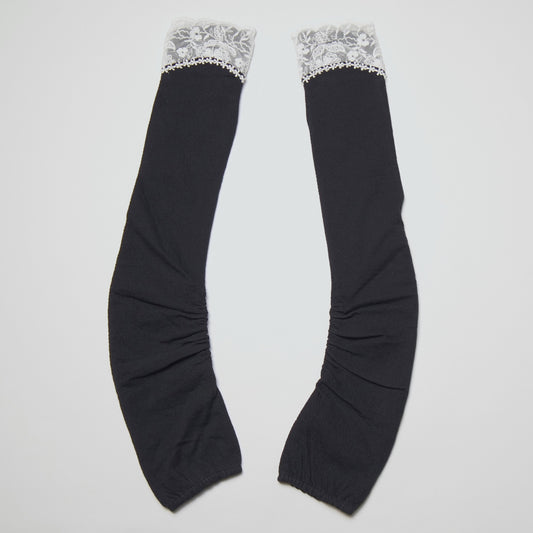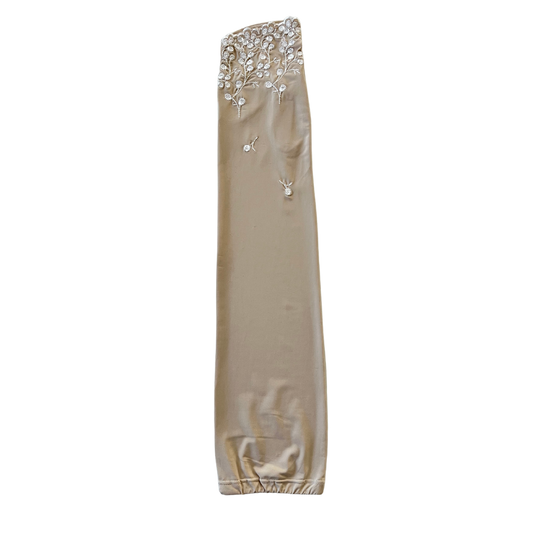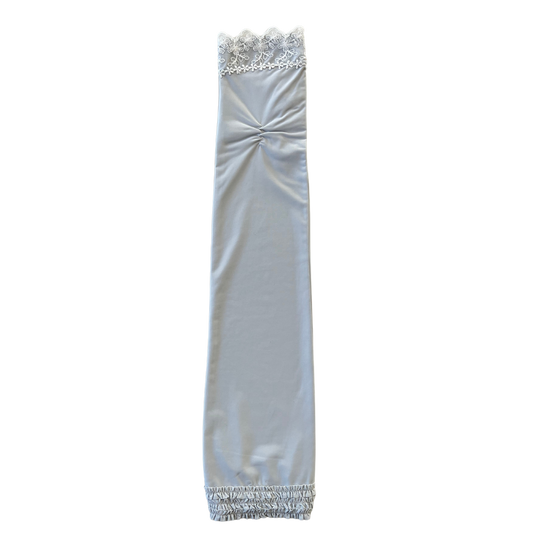“Why do I feel uncomfortable when I put on an arm cover that feels cool to the touch?”
"I want to know about arm covers that are cool and comfortable to wear."
When you put on the arm cover, it feels cool and makes you feel cool.
Therefore, this time I will explain the following.
- The reason why it feels cool is because it is a material that feels cool to the touch.
- Specific examples of materials that feel cool to the touch
- Contact coolness reference value Q-max
- Three points to note about materials that feel cool to the touch
If you read this article to the end, you will understand why arm covers are so cool, so please use this as a reference when choosing an arm cover.
Click here for the UV arm cover made of material that feels cool to the touch.
The cooling effect is caused by the material that feels cool to the touch!

The reason why clothes and futons feel "cool" is because of the materials that are said to have a cool-to-touch feel.
Cool-to-touch materials are fabrics that feel cool to the touch, and are influenced by the following three factors.
- Contains a lot of water in the fiber
- High thermal conductivity and thermal diffusivity
- Feels a little hard when you touch it (shari feeling)
I will explain the above three in detail.
fiber contains a lot of water
The hygroscopic property of fibers is that the polymer compounds in fibers are ``hydrophilic groups,'' making it easy to adsorb and absorb moisture.
When there is a humidity difference between the inside and outside of the fibers, the heat of vaporization that occurs when moisture is absorbed from the inside and released to the outside causes the temperature inside to drop, making you feel cool.
Heat of vaporization is a phenomenon in which a liquid changes into a gas.In the summer, when water is sprinkled on the ground, the water absorbs heat from the ground and changes into a gas, which lowers the temperature of the ground and makes it cooler. .
For example, cotton, which is often used in clothing, is particularly hygroscopic, so it absorbs heat from your skin, making you feel cool.
High thermal conductivity
High thermal conductivity means that heat can be easily dissipated.
For example, when you touch iron, it feels cool because iron has high thermal conductivity, which draws body heat away from your hands.
Heat moves from high temperature to low temperature, and the higher the thermal conductivity, the faster the heat is transferred, making it feel cooler.
The thermal conductivity of the main fibers is as follows.
|
air |
cotton |
hemp |
silk |
polyester |
Nylon |
|
|
Thermal conductivity (W/m・k) |
0.0241 |
0.54 |
0.63 |
0.44 |
0.20 |
0.38 |
The breathability of fibers varies depending on the way the threads are woven, so comfort cannot be determined based on thermal conductivity alone, but the reason why many clothes are made of hemp material in the summer is because you can experience the cooling effect. Probably.
(How to determine thermal conductivity Source: Boken https://www.boken.or.jp/find_tests/functionality/comfortability_heat/1229/ )
Feels a little hard to the touch
 The reason it feels a little hard to the touch is because the fibers contain a lot of water.
The reason it feels a little hard to the touch is because the fibers contain a lot of water.
The cool feeling you feel when you touch your skin is called shari.
It is a word that describes the refreshing feel of summer fabrics such as cotton and linen, which are moisture-absorbing and quick-drying materials that are comfortable to wear and do not stick to the skin.
The reason why cotton and linen have a crisp feel is because they are made from strong, high-strength yarn made by twisting threads together.In addition to increasing the strength of the fibers, they also have good moisture absorption and quick-drying properties, making them ideal for wearing. Sometimes it feels cool.
The standard for cool touch is Q-max.
There is a ``contact cool/warm sensation evaluation value Q-max (W/㎤)'' as a numerical value that expresses the cool touch sensation.
Q-max, which expresses the amount of instantaneous heat transfer from the skin to the fabric, is evaluated as colder as the value is higher, and a value of 0.2W/cm2 or more is a guideline for feeling cold.
The value that is considered to have a high Q-max is 0.6 for concrete, but the Q-max of the main fibers is as follows.
|
cotton |
hemp |
silk |
polyester |
Nylon |
|
|
Q-max (W/㎠) |
0.30 |
0.35-0.4 |
0.30 |
0.3-0.35 |
0.3-0.35 |
The Q-max value is determined by touching a sample at room temperature with a measuring part heated to +10°C (ΔT=10°C) or +20°C (ΔT=20°) of room temperature, and measuring the heat absorption rate of the sample. It is.
(Quote: Kaken https://www.kaken.or.jp/test/search/detail/5#ID1 )
Specific material that feels cool to the touch
There are several specific fibers that provide a cooling sensation to the touch. Commonly used clothing fibers include natural materials such as cotton and linen, while synthetic fibers include polyester, nylon, and rayon.
Synthetic fibers have lower hygroscopicity than natural materials, but nylon has higher moisture absorption than other synthetic fibers.
However, even fibers with low moisture absorption can have a moisture permeability effect if they are breathable, so a material that has both moisture absorption and breathability can be said to be a material that feels cool when worn.
3 points to note about materials that feel cool to the touch

There are three things to keep in mind when using materials that feel cool to the touch:
- It doesn't actually get colder
- The coldness won't last forever
- It is better not to choose based on Q-max criteria alone.
I will explain the above three points in detail.
It doesn't actually get colder
I have explained that cold sensation is the feeling of coolness when you touch something.
Therefore, it is not something like ``clothing feels much colder'' or ``body temperature or clothing temperature decreases.''
Remember that the "coolness" that occurs when you touch clothing etc. is instantaneous.
The coldness won't last forever
The "coolness" that occurs when you touch something doesn't last forever.
Wearing an arm cover means that your skin and arm cover are in constant contact, so there is no temperature difference between the two, so there is no heat transfer, and you no longer feel the coolness that occurs when you put it on.
It is better not to choose only based on Q-max criteria.
Even if Q-max is high, if it is not breathable, the space between your skin and clothes will get stuffy and you will not be comfortable, so it is better not to choose based only on Q-max criteria.
In particular, care must be taken with the arm cover as it is in constant contact with the skin.
Synthetic fibers such as polyester and nylon are used as materials that feel cool to the touch, but they have lower moisture absorption than natural materials.
The key is to choose a material that has both moisture absorption and breathability.
summary
This time I explained the following:
- The reason why it feels cool is because it is a material that feels cool to the touch.
- Specific examples of materials that feel cool to the touch
- Contact coolness reference value Q-max
- Three points to note about materials that feel cool to the touch
You'll also want to choose a product that's comfortable to wear as an arm cover, which is essential for summer sun protection.
We highly recommend arm covers made of cotton and linen materials that also have UV protection !





